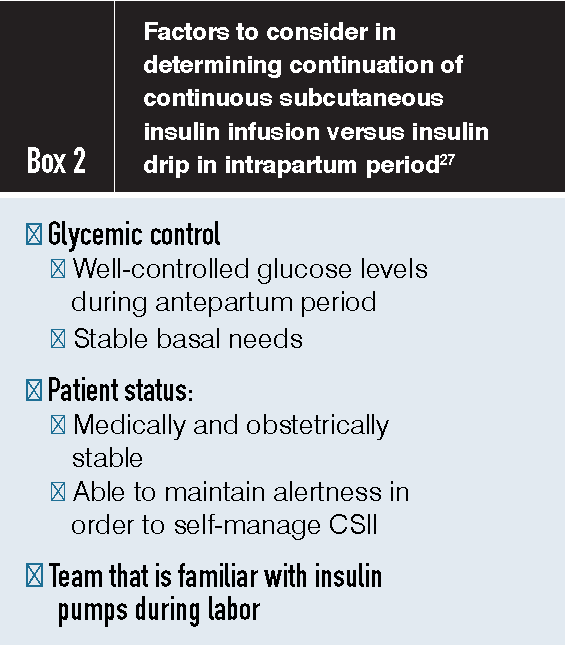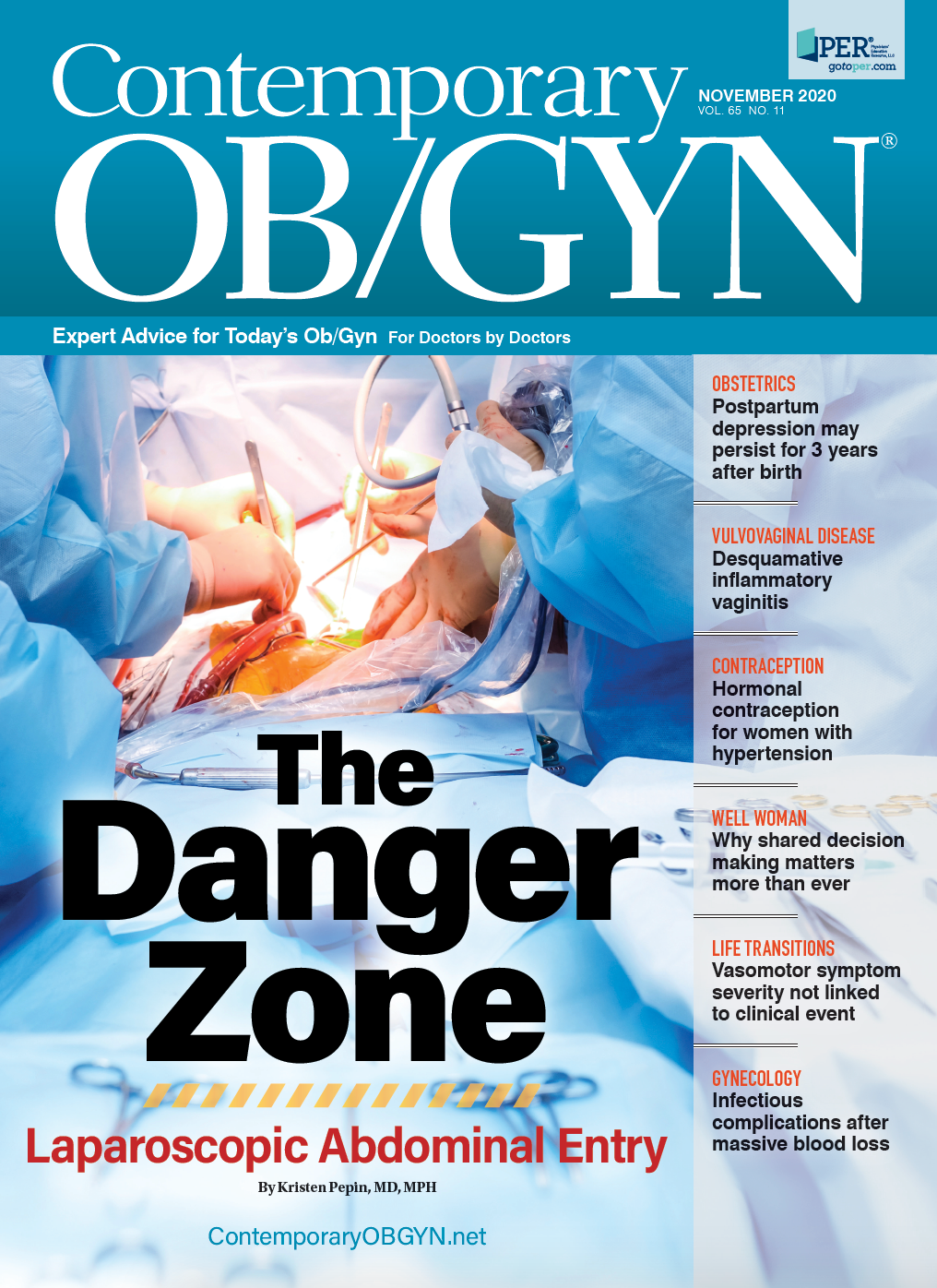Christina S. Han, MD
Han is a Maternal-Fetal Medicine Specialist in Los Angeles at the Center for Fetal Medicine and Women’s Ultrasound. She is the MFM Fellowship Program Director at the University of California, Los Angeles.
Peer-reviewed
A review of the science and technology behind current insulin pumps and CGMs for managing type 1 diabetes mellitus in pregnancy.
Type 1 diabetes mellitus (T1DM) is an autoimmune condition that causes pancreatic beta-cell destruction and complete absence of native insulin production. Risk factors for development of T1DM include family history, genetic predisposition (specific human leukocyte antigen gene variants), and viral triggers.1
Han is a Maternal-Fetal Medicine Specialist in Los Angeles at the Center for Fetal Medicine and Women’s Ultrasound. She is the MFM Fellowship Program Director at the University of California, Los Angeles.
While T1DM affects only 5% of patients with pregestational diabetes and less than 1% of overall pregnancies, it is important that obstetricians are aware of the pathophysiology, basic management principles, and rapidly evolving insulin pump and continuous glucose monitoring (CGM) technologies.
Richley is an ob/gyn in Los Angeles at the University of California, Los Angeles Medical Center and practices at Ronald Reagan UCLA Medical Center and Santa Monica Medical Center.
Patients with poorly controlled T1DM have higher risks of preeclampsia, fetal growth abnormalities, polyhydramnios, intrauterine fetal demise, diabetic ketoacidosis, cesarean delivery, and wound infections.2
In order to optimize glycemic control and pre-conception hemoglobin A1c, referral to both a maternal-fetal medicine physician and an endocrinologist is important for all individuals with reproductive potential.
Preemptive optimization of comorbidities and hemoglobin A1c levels may decrease the risk of congenital birth defects and miscarriage.
Over the past 20 years, there has been a paradigm shift in management of T1DM from self-monitoring of fingerstick capillary blood glucose to CGM and from multiple daily injections (MDI) of insulin to continuous subcutaneous insulin infusion (CSII, colloquially known as “insulin pumps”).
This review will discuss the science and rationale behind these technologies.
CGMs were first introduced in 1999, with the clinical intent of improving patient’s self-awareness of real-time glycemic control, and reducing the cumulative burden of disease management.3,4 These monitors utilize a glucose-oxidase enzyme reaction to measure the glucose concentration in interstitial fluid and converts the value via algorithms to expected glucose concentration in the blood.5
These devices calculate the capillary blood sugar every 5 minutes, then report the value in real-time via short-range wireless communication to a receiver, mobile device, or insulin pump. The data is reported as 288 distinct data points per day.
The analytics generated from the data stream allows both the patient and the physician to visualize trends and changes in the blood sugar in either real-time or retrospectively.
The ability to pinpoint specific time points of glucose perturbations and nutrition deficits may explain periods of poor glucose control, and allow for better management strategies. Drilling down to this level allows the provider to adjust insulin doses based on patient physiology, diurnal cycles, time of day, and specific meals.
Furthermore, impending hypo- and hyperglycemia can trigger an audible alarm that allows for preemptive self-treatment with oral glucose or insulin as indicated.
While the data is mixed, use of CGM has been shown in multiple trials to improve outcomes in both pregnant and non-pregnant patients being treated with CSII or MDI of insulin.6,7 Notable clinical improvements with CGM use include decrease in hemoglobin A1c levels, increased times within target glucose goals, and decreased frequency of hypoglycemic events.6,8
Some data also suggest that CGM also may confer benefit for patients with type 2 diabetes. Initiation of CGM is strongly recommended for pregnant individuals with T1DM.9 Some studies have found lower rates of preeclampsia, improved hemoglobin A1c, and decreased rates of fetal macrosomia.10 There have been no adverse events related to the use of CGMs and no side effects or adverse events have ever been associated with using CGMs in or outside of pregnancy.
Both hardware and algorithmic improvements are continuously being instated for CGMs.3 Traditionally, CGMs required the user to periodically obtain fingerstick glucose levels via a glucometer to calibrate the sensor signal.
Modern CGM devices have improved in insertion, calibration, and accuracy. Newer models allow patient self-insertion subcutaneously every 7 to 10 days, have internal calibration systems, which eliminate the need for finger sticks, and have significantly decreased the mean absolute relative difference from the gold standard (25% in older models, down to 9-12%).
Despite the improvements in calibration, intermittent capillary blood glucose checks still are recommended to make sure the readings are accurate.
Of note, healthcare providers need to be aware that acetaminophen is contraindicated in all patients on CGMs because the drug binds to, and interferes with, the sensor and will significantly alter the values reported. Newer models of the Dexcom CGM have begun to address this particularity in the sensors.11
There are currently four major CGM products available in the United States: Medtronic, Dexcom, FreeStyle Libre, and Senseonics Eversense (Figure 1). Dexcom is the only model that currently has Food and Drug Administration (FDA) approval to make insulin management decisions independent of a closed-loop system.
The remaining models require an additional point-of-care glucose check to confirm the glucose level before insulin or sugar can be administered. The Dexcom and Medtronic CGMs can be used in closed-loop insulin systems, which are described below.
Figure 1.

It is important to note that none of the products have FDA approval for use in pregnancy.
Most CSII have a reservoir of insulin that is connected to an electronic pump. The pump is connected to tubing that delivers the insulin subcutaneously via an external port placed subcutaneously by the patient. The anatomical sites used are typically abdomen, anterior thigh, and posterior upper arm, all regions that remain accessible to the pregnant individual.
The exception to this model is the Omnipod.
This specific CSII has the infusion site, insulin reservoir, and pump all at the level of the skin, eliminating the need for tubing. It also has a separate device that allows the patient to control the pump via Bluetooth wireless communication.
Most CSII now have built-in insulin bolus calculators, based on the prescribed insulin-to-carbohydrate ratios of the patient. This feature eliminates human math errors that can lead to incorrect dosing of insulin, a potentially dangerous event.
The basal rates and bolus amounts are fine-tuned across all CSII to a meticulous level of accuracy. The basal rates can be fine-tuned to a level of 0.1 units/hour (or 10 microliters/hour) and bolus volumes can be calculated to a level of 0.05 units to 0.1 units, depending on the type of CSII.
Box 1

This level of accuracy is superior to traditional insulin injections that have an accuracy of 0.5 units per dose.
But even with all the advancements in device accuracy and technology, are pumps truly better than daily MDI in pregnancy?
Within the last 10 years, most studies looking at CSII vs MDIs have found superior glycemic control outside of pregnancy,3 and one study in pregnancy showed superior glycemic control but no improvement in neonatal or obstetrical outcomes.6 However, this study was not powered to evaluate pregnancy outcomes.
Literature remains sparse on the efficacy of CSII in pregnancy.
Patient characteristics to consider in recommendation and initiation of CSII in a patient requires evaluation of several factors, listed in Box 1. It is also important to note that physicians need to ensure that the patient has achieved adequate glycemic control prior to the transition to a CSII, as premature initiation during a period of poor control can be potentially dangerous for the patient.
This increased risk is secondary to the exclusive use of short-acting insulins in CSIIs, which require that the user be savvy and experienced in adjustments.
A potential lapse in dosing or temporary interruption due to inexperienced use can increase risk of diabetic ketoacidosis or other complications, compared to patients on MDI who have coverage with some basal insulin throughout the day.
Box 2

There are five major manufacturers of CSII today, and all have similar efficacy. The differences are the presence of minor features that come down to patient preference of the interface (Figure 2).
Closed-loop insulin systems represent the pinnacle of T1DM technology. In closed-loop systems, the CGM communicates directly with the CSII to adjust basal rates and provide micro-boluses throughout the day, further reducing the daily burden of disease management and potential for human error.
The governing algorithms can see trends in glucose readings and decrease basal rates when hypoglycemia may occur and can give micro-boluses when a trend towards hyperglycemia is detected. This leads to less corrective dosing regimens in the future and overall better control.
There have been multiple studies on closed-loop systems outside of pregnancy that have shown decreased rates of hypoglycemic episodes, more time in glycemic target range, and improved hemoglobin A1c.12, 13
One study in pregnant women showed more time in target range compared to previous standard of care.14 While no study has looked at neonatal and pregnancy outcomes, given the ability to improve blood sugar control, there may be benefit to the closed-loop system in pregnancy.
To date, no randomized control trials have evaluated the use of intravenous insulin versus subcutaneous injections versus CSII therapy for intrapartum management. Patient and fetal/neonatal safety are of the highest priority while patients are in labor, so a standardized protocol determined by a multidisciplinary team of endocrinologists and maternal-fetal medicine specialists is recommended.
Figure 2

While CSII may lead to better control of blood sugars and patient autonomy, labor floor providers who are unfamiliar with CSII may choose to transition to insulin drips.
Further studies of intrapartum management of T1DM need to be performed to further assess safety of continuation of CSII in various labor and delivery models and populations.
One of the most significant barriers to obtaining this technology is variable insurance coverage. Most, but not all, insurance plans will cover CSII and CGMs for T1DM patients. If coverage is not provided by the insurance company the cost of the CSII system can be between $4,500-$6,000 with annual costs of about $3,500 for supplies.17
As research continues to demonstrate the superior control and improved long-term outcomes, we anticipate that more insurance companies will cover this essential technology.
From a societal perspective, there have been multiple cost-effectiveness studies evaluating CSII. The data remains conflicting on the optimal management protocols, with differing models yielding different cost-effectiveness outcomes when comparing MDI, CSII with CGM, and closed-loop systems.12,16,17
When evaluating CGM alone, in the absence of an insulin delivery system, most studies have found that there is a cost-benefit of using CGMs compared to multiple point-of-care glucose tests throughout the day.18
But, given the heterogeneous data, it is unclear if there is a cost-benefit of using CSII and CGMs in combination.
However, if these technologies can potentially reduce the risk of chronic sequelae, such as kidney disease, vascular disease, cardiac disease, and neurologic disease, there may be a long-term cost-benefit analysis. These long-term outcomes have not been evaluated yet as these technologies are relatively new.
A recent poll of T1DM patients revealed about one-third currently use an insulin pump.10 This number is expected to increase given the emerging evidence of superior control, increased safety with use, and expansion of insurance coverage.
There is also a movement toward placing poorly controlled T1DM on closed-loop systems because of the reduction of human error with this type of technology. It is now up to the obstetrics community to ensure that these technologies and their continued advancements are studied adequately in pregnant individuals.
Dr. Han is a Maternal-Fetal Medicine Specialist in Los Angeles at the Center for Fetal Medicine and Women’s Ultrasound. She is the MFM Fellowship Program Director at the University of California, Los Angeles.
Dr. Richley is an ob/gyn in Los Angeles at the University of California, Los Angeles Medical Center and practices at Ronald Reagan UCLA Medical Center and Santa Monica Medical Center.
__
References
